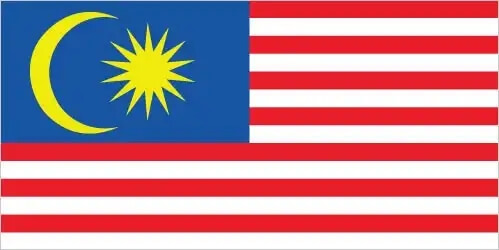World Book
Malaysia
World Book Index
70


With a score of 70, the country is ranked 61st out of 158 countries in the World Book ranking. (more information)
Introduction
Background
The British secured and colonized the area that is now Malaysia during the late 18th and 19th centuries. In 1948, the British-ruled territories on the Malay Peninsula (except Singapore) formed the Federation of Malaya, which became independent in 1957. Malaysia was formed in 1963 when the former British colonies of Singapore, as well as Sabah and Sarawak on the northern coast of Borneo, joined the Federation. Singapore was expelled in 1965.
Geography
Area
total : 329,847 sq km
land: 328,657 sq km
water: 1,190 sq km
Climate
tropical; annual southwest (April to October) and northeast (October to February) monsoons
Natural resources
tin, petroleum, timber, copper, iron ore, natural gas, bauxite
People and Society
Population
total: 34,564,810 (2024 est.)
Ethnic groups
Bumiputera 63.8% (Malay 52.8% and indigenous peoples, including Orang Asli, Dayak, Anak Negeri, 11%), Chinese 20.6%, Indian 6%, other 0.6%, non-citizens 9% (2023 est.)
Languages
Bahasa Malaysia (official), English, Chinese (Cantonese, Mandarin, Hokkien, Hakka, Hainan, Foochow), Tamil, Telugu, Malayalam, Panjabi, Thai
Religions
Muslim (official) 63.5%, Buddhist 18.7%, Christian 9.1%, Hindu 6.1%, other (Confucianism, Taoism, other traditional Chinese religions) 0.9%, none/unspecified 1.8% (2020 est.)
Population growth rate
0.99% (2024 est.)
Government
Government type
federal parliamentary constitutional monarchy
Capital
name: Kuala Lumpur
Executive branch
chief of state: King Sultan IBRAHIM ibni al-Marhum Sultan Iskandar (since 31 January 2024)
head of government: Prime Minister ANWAR Ibrahim (since 24 November 2022)
Diplomatic representation in the US
chief of mission: Ambassador Tan Sri Muhammad SHAHRUL Ikram bin Yaakob (since 24 July 2025)
Diplomatic representation from the US
chief of mission: Ambassador Edgard D. KAGAN (since 20 March 2024)
Economy
Economic overview
upper middle-income Southeast Asian economy; implementing key anticorruption policies; major electronics, oil, and chemicals exporter; trade sector employs over 40% of jobs; key economic equity initiative; high labor productivity
Real GDP (purchasing power parity)
$1.212 trillion (2024 est.)
$1.153 trillion (2023 est.)
$1.113 trillion (2022 est.)
Real GDP per capita
$34,100 (2024 est.)
$32,800 (2023 est.)
$32,100 (2022 est.)
Exports
$301.789 billion (2024 est.)
$274.1 billion (2023 est.)
$312.88 billion (2022 est.)
Exports - partners
China 21%, Singapore 12%, USA 12%, Japan 5%, Hong Kong 5% (2023)
Exports - commodities
integrated circuits, refined petroleum, crude petroleum, natural gas, palm oil (2023)
Imports
$279.09 billion (2024 est.)
$253.665 billion (2023 est.)
$283.758 billion (2022 est.)
Imports - partners
China 24%, Singapore 11%, USA 7%, Japan 5%, Taiwan 5% (2023)
Imports - commodities
integrated circuits, refined petroleum, crude petroleum, coal, broadcasting equipment (2023)
Human Development Index
The country's Human Development Index (HDI) is 0.819, ranking it 67th out of 193 countries tested. (more information)
World Happiness Report
The World Happiness Report ranked the country 66th out of 158 countries tested with a score of 5.942. (more information)



